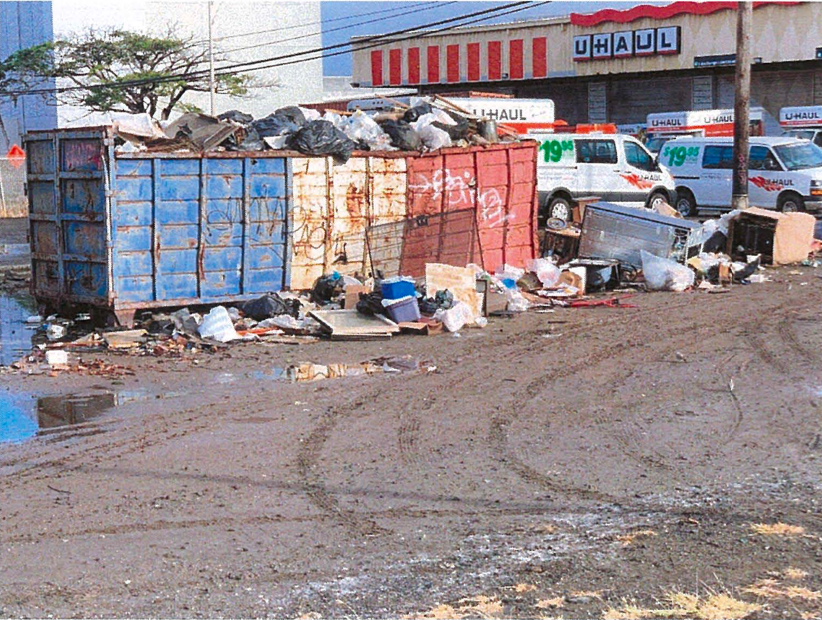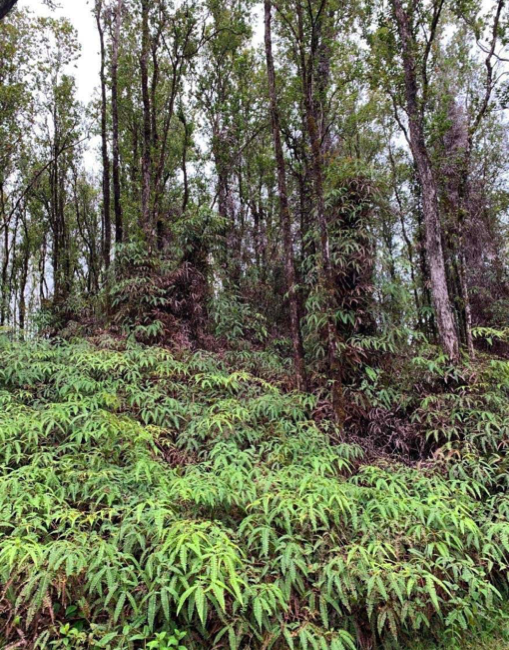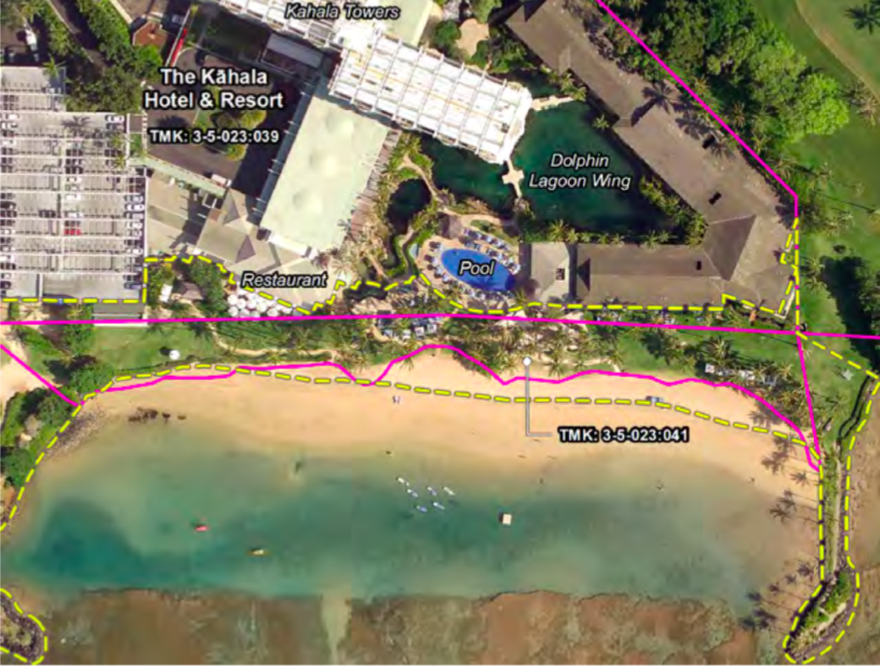Dumper Claims DLNR Owes Damages for Removed Bin

Credit: DLNR
As if the DLNR didn’t have enough problems with dumping on its lands, late last year, the agency’s Land Division learned that someone left a roll-off container full of trash on an unencumbered industrial lot in Mapunapuna, O‘ahu. Despite the posting of a notice of violation on the container, another one showed up right next to it in January. A violation notice was placed on that one, as well.
The agency’s maintenance crew eventually determined, based on the colors painted on the containers, that they belonged to The Trash Man, LLC, a refuse hauler. Owner John Guinan explained in a February letter that his truck had broken down and the insurance for his equipment had expired, so the containers were left on the state parcel. And because the bins’ loads had become too heavy under Department of Transportation rules to take onto the highway, he could not move them.
Later that month one of them was removed. The other stayed put. According to texts and correspondence between Guinan and Land Division agent Robert Medeiros in February, Guinan was prepared to deliver an empty container to take some of the load from the one on state land so it could be hauled away, but Medeiros advised him to hold off. The Land Division had already begun working with a competing hauler to remove the bin and its contents.
But nothing happened. And for months afterward, trash continued to pile up in and around the bin.
“[A]fter the roll-offs were placed on the premises, they served as an attraction for other people in the vicinity to treat the land as a dump site. So, rubbish started to accumulate very quickly,” a Land Division report to the board states.
In early August, a state legislator emailed the DLNR photos of all the trash. The department then hired HTM to quickly remove the roll-off, despite Guinan’s renewed offer to have his company do it.
In its October 9 report, Land Division staff recommended that the Land Board find The Trash Man liable for the $3,278 it cost to remove the roll-off and its contents and $1,758.54 in administrative costs. It recommended a fine of $5,000 for the dumping, and charging the company $17,431 in back rent for using the site from December 17 through August 5.
“[Guinan] decided to comply with the Department of Transportation rules about load limits on public highways and did not take the loaded roll-off onto the public highway. Nevertheless, he chose to ignore our posted notice prohibiting dumping on state lands by bringing in the roll-off containing rubbish onto our site without any authorization,” the staff report stated.
Land Division administrator Russell Tsuji told the board that his agency would never actually rent the property for storing roll-offs, but opted to seek back rent, rather than pursue the hefty fine that would have been allowed under DLNR rules. Under those rules, The Trash Man faced potential fines of $500 a day for 233 days, or $116,500.
“Due to the lack of timely response to this situation, Land Division acknowledges that it may not be equitable to impose the full amount of the fine against The Trash Man, LLC. Land Division is therefore amenable to accepting the payment of back rent for use of state lands together with the reimbursement of the clean-up cost and administrative charges and a fine of $5,000,” the report stated.
It added in a footnote, “O‘ahu Land Division staff will have to conduct more programmed patrol or inspection of the parcels under the jurisdiction of Land Division in the future before any unauthorized uses of State lands become escalated. More immediate actions are needed to enforce any applicable statutes or rules governing the orderly management of State lands.”
Faced with having to pay nearly $30,000 in fines and costs, The Trash Man (TTM), through its attorney Thomas Zizzi, requested a contested case hearing.
In an October 8 letter to the board, Zizzi argued that because the company was prepared to remove the roll-off itself, it shouldn’t have to pay any fines or costs. In fact, he said the DLNR should pay to replace the container that it had hauled away.
“The only reason the container remained on the site was because DLNR told TTM to not take action to remove it. Further, under the current governmental proclamations, eviction of a tenant has been suspended. If DLNR is asserting landlord rights to receive rent, then it is hereby implicitly asserting a tenancy to which it is not allowed to take action upon under current proclamations,” Zizzi wrote.
He then claimed that TTM could have easily removed the container and that the DLNR ignored the company’s right to remove its own property.
Public Hearings On Proposed Waiea Reserve

On October 23, the Land Board approved a request by the DLNR’s Division of Forestry and Wildlife to hold virtual public hearings on a proposal to add 1,260 acres of former ranch land on the western flank of Mauna Loa to the state Natural Area Reserves system.
Formerly under lease to McCandless Ranch, the land, located a mile mauka of Highway 11, contains mesic and wet native forest ecosystems. Unlike other wet forest ecosystems in the state, which evolved under a winter wet season regime, the Waiea lands’ ohi‘a-dominated forests evolved under a summer wet season, a DOFAW report states.
Federally listed forest birds, including akiapola‘au, ‘akepa, ‘alawi, and ‘i‘iwi, inhabit adjacent lands, which are under control of the U.S. Fish & Wildlife Service. The lands also used to support populations of the endangered ‘alala, which is now, again, extinct in the wild. Three endangered bellflower species are scattered throughout the area.
DOFAW states that protecting the land will improve the watershed that area residents rely on for fresh water and reduce erosion.
“While Natural Area Reserves are generally open to the public, Waiea is landlocked so no public access is anticipated,” the report states. DOFAW can, however, access the lands for management purposes through the adjacent National Wildlife Refuge.
(Environment Hawai‘i has written about disputes over the Waiea tract between the state and the permittee since our April 1991 article, “A Decade-Long Standoff over Access to Wild Birds.” That article and many more on the subject are available at environment-hawaii.org.)
Board Renews Permit To Kahala Hotel

The revocable permit approved by the Land Board last year for a 1.3-acre strip of beachfront land fronting the Kahala Hotel & Resort required ResortTrust Hawai‘i to ensure public access “to the extent the area is not occupied for a use allowed under the permit.” Those allowed uses included the pre-setting of 70 lounge chairs.
The permit also required the hotel to maintain two 20-foot wide mauka-makai pathways for public pedestrian access.
Those conditions apparently fell short of providing the type of public access that Land Board members, as well as longtime critics of the permit, believe is required.
When the DLNR’s Land Division brought its recommendation to the board on October 23 to renew the permit with the same conditions as last year, board member Vernon Char voiced his concern that the existing signage on the property and the way the hotel had set out its chairs discouraged public use.
After having walked the site a day earlier, he praised the hotel for its excellent maintenance of the sandy beach fronting the state parcel. However, he continued, “it was unclear if the shower on the lot was available [for use by the public] and the chairs were spread pretty much throughout the grassy area so that it almost seemed preemptive from public use. … It was not obvious to me where the public would have access.”
Attorney Jennifer Lim, representing ResortTrust, replied that the entire property, including the shower, was open to the public. She said that there were signs indicating where the hotel’s property was, a sign welcoming the public, and also signs informing people they are “welcome to pass through mauka to makai.”
“The hotel doesn’t restrict people on the property. Just the chairs that are permitted under the RP, those would be for hotel guests,” she said.
In his testimony before the board, David Kimo Frankel, who had sued over the approval of last year’s permit, explained why he believed the hotel and the board were obligated to do much more to facilitate the public’s use of the land.
“[Land Division] staff never provides to you the origins and purposes of this lot. And that is, in the early 1960s, the Kahala Hotel Company, Bishop Estate [now Kamehameha Schools, which leases the land under the hotel to ResortTrust] and others wanted the City Council to rezone this property
so the hotel could be built. In exchange for rezoning, Bishop Estate and the others promised to create a ‘good beach for the public’ and the public would have free access to it,” he said.
He also pointed out in written testimony that the land had been “dedicated in a Land Court document, to be ‘used as a public beach.’” And until the 1980s, the parcel was, indeed, a wide, sandy beach that extended up to the hotel property.
Since then, the lot has been grassed over and for years had been used by the hotel to host weddings, as part of a hotel restaurant, and for cabana rentals and other commercial uses. That is, it did so until Frankel, area resident Tyler Ralston, the Sierra Club and others complained and the city advised the company that those uses were prohibited within the Special Management Area.
The hotel has scaled back on the amount of furnishings it sets out on the property, but Frankel emphasized that there is still asignificant section of the lot that is unused by the public because of a hedge the hotel planted in the 1980s. Nobody sits in that area because the hedge prevents anyone on the grass from seeing the ocean or getting into the water, he said.
“So when they give you this misleading statistic that 3 percent or 6 percent of the land is what they want to put their beach chairs on, that’s because they ignore this entire area, the Diamond Head side of the property,” he said.
He also argued that 70 pre-set beach chairs is too many. “All those chairs make it impossible for the public to use [the property]. What the hotel does is exclude people by putting the chairs out early in the morning, in the most desirable spots. …. Why are we reserving the
best spots for the rich folks? That’s not what a democratic society is supposed to be about,” he said.
He recommended that the board include conditions in the new permit that would bar the commercial use of the property and prohibit the pre-setting of chairs.
“If you do that, the hotel will continue to maintain the property. … It will allow the hotel guests to use the property, just as members of the public do, but not in a preferred way,” he said.
Ralston argued against approving the permit and told the board that the hotel had actually excluded him from the property when he wanted to sit on the grass.
Board member Char also questioned the wisdom of allowing pre-setting of chairs.
“I voted for the RP the last time, but this time, I’m up in the air whether the pre-set chairs, whether it was more of a preemption of the public thinking it was hotel property. … To pre-set, especially with the lack of clear identification [of public access], creates confusion,” he said.
To clear up the confusion about where the hotel property ended and the state’s began, board member Tommy Oi said he wanted the hotel to delineate on the ground the mauka boundary of the state parcel.
Board member Yuen agreed that it should be made clearer to the public that the grassy area makai of the hotel property is a public use area, except for the hotel chairs.
Board member Gon then suggested that perhaps the hotel could refrain from pre-setting altogether or at least pre-set no more than 25 percent of the 70 chairs allowed under the permit.
Board member Kaiwi Yoon asked Kahala hotel manager Joe Ibarra whether it was the hotel’s intent to meaningfully include kama‘aina and the public.
Ibarra replied that it absolutely was. “We are stewards of this property,” he said, noting that he is a native Hawaiian and graduate of Kamehameha Schools. “The beach was constructed with the intent of public access as well as hotel use,” he said.
Yoon said the hotel could do more to provide an “authentic experience,” where visitors and locals mingle together. “To make it well-known that the public can access this great space I think is very important,” he said.
In the end, the Land Board voted to renew the permit, with new conditions: that the hotel clearly delineate the boundary between the public and private property and install signage to make it clear to members of the public that they are welcome on the public land.
Board chair Suzanne Case also reminded the hotel representatives earlier in the meeting that that the chairs should not obstruct public use.
— Teresa Dawson

Leave a Reply